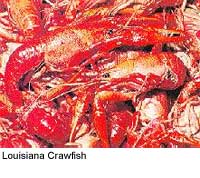|

 Moulting: Crayfish need to moult as they grow because their hard exoskeletons
do not allow much room for expansion. Baby crayfish can moult on
a daily basis but as they grow older, the regularity of moults decreases
to a period of weeks or even months. The first few days after a
moult, a crayfish's skin is very soft and it is very vulnerable
to attacks from other animals and crayfish. Moulting: Crayfish need to moult as they grow because their hard exoskeletons
do not allow much room for expansion. Baby crayfish can moult on
a daily basis but as they grow older, the regularity of moults decreases
to a period of weeks or even months. The first few days after a
moult, a crayfish's skin is very soft and it is very vulnerable
to attacks from other animals and crayfish.
Early Signs: The early signs of moulting include lack of appetite and a slowdown
in activity. During this period the crayfish ingests calcium into
an internal organ, not into the exoskeleton.
Hiding: When the crayfish is ready to moult, it will try to find a hiding
spot. Then it will move onto its back and begin fanning its pincers,
legs and swimmerets (under the tail) in order to get as much oxygen
as possible. The carapace will begin to crack behind the head; the
new appendages then pierce the old shell; and then after about five
minutes, a sudden, violent movement will detach the old shell from
the crayfish.
Vulnerable: The freshly moulted crayfish will invariably be larger as part
of the growing process, but is vulnerable on several fronts. Firstly,
the shell is very soft and vulnerable to predators, including other
crayfish and fish. The crayfish needs to eat the old shell to replace
the lost calcium and stengthen the weakened carapace.
Pets: Crayfish are sometimes kept as pets in freshwater aquariums. They
prefer foods like shrimp pellets or various vegetables but will
eat most leftover fish food. They also have a big appetite for plants
and will eat most aquarium plants. They can be aggressive and may
attempt to eat fish. However, crayfish are actually fairly shy and
may often attempt to hide under leaves or rocks. If you are going
to keep a crayfish as a pet, remember to give it some hiding space.
At night, some fish become less energetic and settle to the bottom.
The crayfish might see it as a danger and hurt or kill it with its
claws. Crayfish are great escape artists and may try to climb out
of the tank so any holes in the hood should be covered. In nations
where imported alien crayfish are a danger to rivers, such as England,
catching and keeping crayfish as pets is one of the main means of
the spread of destructive species - since they are often flung back
into a different river.
All text is available under the terms
of the GNU Free Documentation License
|